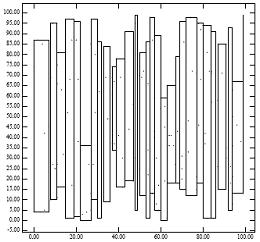Introduction
R-trees is one of the most efficient methods that support range queries(查询)
The most successful variant of R trees seems to be the R*-tree.
main contribution
defer the splitting
choosing some rectangles from the overflowing node, and “force-reinserting”
Hilbert R-tree main idea
propose(提出) an ordering of the data rectangle
- Require:
- Each R-tree node has a well defined set of siblings(purpose:using the B*-tree algorithms for deferred splitting 可以达到类似B*树一样的对空间的高利用率)
- R*树对利用率没有过多的关心,平均利用率只达到了70%
使用了不规则的数据进行了实验->Static Hilbert R-trees/Dynamic Hilbert R-tree
在Hilbert R树之前的探索
Guttman proposed three splitting algorithms
1. linear split(线性分裂)
2. quadratic split(二次分裂)//能够最好的实现分裂时间和搜索效率的交换
3. exponential split(指数分裂)
Subsequent work on R-trees includes R+-tree,R-tree using Minimum Bounding Polygons(最小边界多边形)R*-tree.All above R-tree varients support insertions and deletions,are suitable for dynamic environments.
Roussopoulos and Leifker proposed a method
利用x,y 坐标实现R树近似100%的空间利用率,连续的矩形数据被分配到相同的叶结点中,直到这个叶结点满了,然后再创建新的叶结点。但是这个时间比R*树和二次分裂R树更差。
Static Version
lowx packing method


忽略了y轴坐标,实际的实验中也证明得出的划分违反了统计学中的经验法则space filling curves
- Z-order
- Hilbert curve
- Gray-code curve
Purpose:使相近的点能够在一个划分中,使得R树的结点矩形能够占据更小的区域








 本文详细介绍了R*-树及其改进技术,包括R树的基本概念、R*-树的主要贡献、Hilbert R树的创新思想以及不同分裂算法的性能比较。重点阐述了R树在空间查询效率和数据结构优化方面的应用,以及如何通过改进实现更高的空间利用率和更好的性能表现。
本文详细介绍了R*-树及其改进技术,包括R树的基本概念、R*-树的主要贡献、Hilbert R树的创新思想以及不同分裂算法的性能比较。重点阐述了R树在空间查询效率和数据结构优化方面的应用,以及如何通过改进实现更高的空间利用率和更好的性能表现。
















 1万+
1万+

 被折叠的 条评论
为什么被折叠?
被折叠的 条评论
为什么被折叠?








